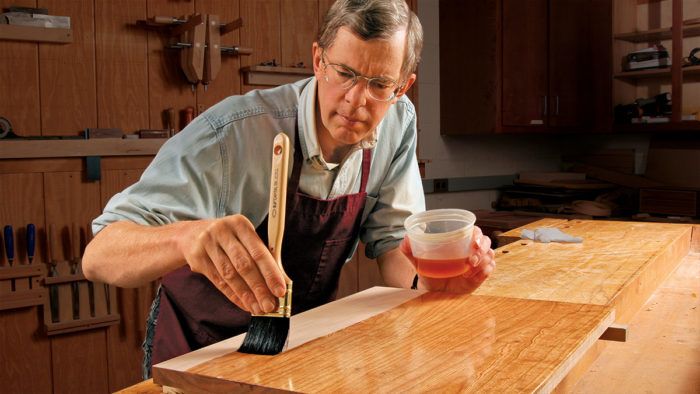The Best Brushes
If you have trouble brushing finishes, you probably aren't using the right tool.

Synopsis: On the surface, a brush is nothing more than a tool for spreading finish. But the correct brush can open up new finishing horizons for any woodworker who normally finishes using a cloth only. One obstacle to getting started, though, are the hundreds of brushes for sale in hardware stores, home centers, and online. They come in all sizes and shapes, at every point on the price scale, and with different types of bristles. This article explains what to look for in a quality brush, why you will get better results using one, and how to keep your brushes working well for many years. You’ll also learn what brushes work best with different types of finish.
Many woodworkers use only one finishing tool—a cloth. That is a shame, because applying a finish with a brush has many advantages: You build up a protective finish much faster; you can use waterborne finishes, which are very hard to wipe; and you waste far less finish than with a spray gun and don’t need a special spray booth.
One obstacle to getting started, though, are the hundreds of brushes for sale in hardware stores, home centers, and online. They come in all sizes and shapes, at every point on the price scale, and with different types of bristles (some with no bristles at all). You want to apply a perfect finish to your just-completed project, but should you spend $50 on a brush or will a $10 one work just as well?
A brush is simply a tool for spreading finish on a surface. But like all tools, there are specialist versions for different products and situations, and to a great extent price does determine quality. I’ll explain what to look for in a quality brush, why you will get better results using one, and how to keep your brushes working well for many years. I’ll also tell you what brushes work best with different types of finish, and suggest a selection that won’t break the budget. You’ll be surprised at how easy brushing can be when you have the right brush.
Your first brush

Start with a 2-in. brush. This is small enough to learn on but large enough to finish most surfaces up to small tabletops. Because most brushes are designed to apply paint, they are stiffer than is ideal for applying most clear finishes. Look for a brush that feels relatively flexible and has filaments around 1/2 in. longer than the brush is wide. Shorter filaments don’t have enough flexibility. Buy a natural-bristle brush for solvent-based finish, or a synthetic-filament brush for water-based finish.
A good place to start: A 2-in.-wide flat brush with a square end will let you develop your brushing skills.
Two other shapes to consider: An angled-sash brush is designed to handle areas of different widths as well as corners and tight spots. Get a size between 1½ in. and 2½ in. Once you’re comfortable brushing and you’re ready to tackle a large surface, buy a round or oval brush. Their extra capacity means fewer trips to reload the brush.
Match the brush to the finish
Despite some manufacturer’s claims, brushes with synthetic filaments can’t match a natural-filament brush when applying a solvent-based finish. Most woodworkers refer to a brush’s bristles rather than its filaments, but that is rather like calling all cheese cheddar. Bristle refers only to hog bristle, also known as China bristle because that is where nearly all of it comes from. Sold to brush-makers for $8 to $12 per pound, bristle is the workhorse among natural-filament brushes.

From Fine Woodworking #212
To view the entire article, please click the View PDF button below.
Fine Woodworking Recommended Products

Tite-Mark Marking Gauge

Jorgensen 6 inch Bar Clamp Set, 4 Pack

Foam Brushes








Log in or create an account to post a comment.
Sign up Log in